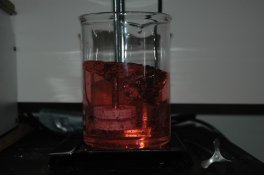Photo Engineer
Subscriber
In response to some questions here are some loose "definitions" for emulsion making.
Stirring is accomplished most simply by a magnetic stirring bar and a magnetic stirrer but it can be accomplished manually with a spoon or spatula. In gelatin, a magnetic stirrer is good from up to about 700 rpm with a good point being 300 rpm and a volume from 100 - 500 ml.
Mixing is accomplished most commonly by a propeller on a shaft and is most efficient at about 100 - 5000 rpm and volumes up to 5 L. You must be careful not to beat air into your emulsion.
Homogenizing is at the upper end of mixing and if the homogenizer has a loose enough gap between the rotor and stator (bigger than the emulsion or say 10 - 20 microns) then it can be used as a "mixer" for emulsion making. However, this gap is critical as a narrow gap can break or shear crystals and fog the emulsion. Generally a homogenizer has a gap of 1 micron or thereabouts and is used to make photographic dispersions of insoluble materials in gelatin. In this latter case a surfactant is needed. There is no limit on size of solution to be homogenized depending on the container used and the size of the rotor/stator. I have used them from test tube size up to liters with the right equipment. Speeds vary up to 25000 rpm or higher. These are dangerous units that can cause severe injury and also they can even overheat the solution being worked with or can shatter glass containers.
See here for a state of the art rotor/stator homogenizer: http://www.ikausa.com/rotor-stator.htm
PE
Stirring is accomplished most simply by a magnetic stirring bar and a magnetic stirrer but it can be accomplished manually with a spoon or spatula. In gelatin, a magnetic stirrer is good from up to about 700 rpm with a good point being 300 rpm and a volume from 100 - 500 ml.
Mixing is accomplished most commonly by a propeller on a shaft and is most efficient at about 100 - 5000 rpm and volumes up to 5 L. You must be careful not to beat air into your emulsion.
Homogenizing is at the upper end of mixing and if the homogenizer has a loose enough gap between the rotor and stator (bigger than the emulsion or say 10 - 20 microns) then it can be used as a "mixer" for emulsion making. However, this gap is critical as a narrow gap can break or shear crystals and fog the emulsion. Generally a homogenizer has a gap of 1 micron or thereabouts and is used to make photographic dispersions of insoluble materials in gelatin. In this latter case a surfactant is needed. There is no limit on size of solution to be homogenized depending on the container used and the size of the rotor/stator. I have used them from test tube size up to liters with the right equipment. Speeds vary up to 25000 rpm or higher. These are dangerous units that can cause severe injury and also they can even overheat the solution being worked with or can shatter glass containers.
See here for a state of the art rotor/stator homogenizer: http://www.ikausa.com/rotor-stator.htm
PE
Last edited by a moderator:










 ), but so far I'm not seeing the kind of follow-up information I was expecting. If 'stirring', 'mixing', and 'homogenization' are meant as vocabulary words, I'd love it if you could add them to your sticky thread, A short dictionary of emulsion making and coating terms. It's my observation/opinion that this forum is getting very bulky and hard to mine for usable information.
), but so far I'm not seeing the kind of follow-up information I was expecting. If 'stirring', 'mixing', and 'homogenization' are meant as vocabulary words, I'd love it if you could add them to your sticky thread, A short dictionary of emulsion making and coating terms. It's my observation/opinion that this forum is getting very bulky and hard to mine for usable information.  )
)



